Family name: Restionaceae R. Brown
Synonym(s): Anarthriaceae D. F. Cutler & Airy Shaw; Centrolepidaceae Endl., nom. cons.; Devauxiaceae Dumort., nom. illeg.; Hopkinsiaceae B. G. Briggs & L. A. S. Johnson; Lyginiaceae B. G. Briggs & L. A. S. Johnson
Common name(s): restio family
*Number of genera/species: 51/572
List of genera record in GRIN-Global
fruit or seed
Fruit dehiscentdehiscent:
(v. dehisce) splitting open at maturity to release contents (of a fruit)
 , loculicidalloculicidal:
, loculicidalloculicidal:
type of capsular dehiscence, opening longitudinally through the locules (compare septicidal)
 capsulecapsule:
capsulecapsule:
a dry, dehiscent fruit formed by two or more carpels
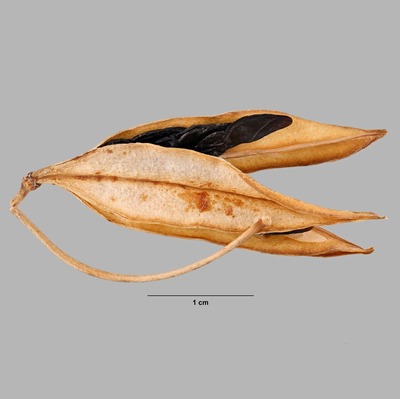 (1–3 locular) or follicle (Centrolepis, Gaimardia), or indehiscentindehiscent:
(1–3 locular) or follicle (Centrolepis, Gaimardia), or indehiscentindehiscent:
not opening on its own, as in a fruit
 , nutnut:
, nutnut:
a fairly large, indehiscent, dry fruit with a thick and bony wall surrounding a single seed
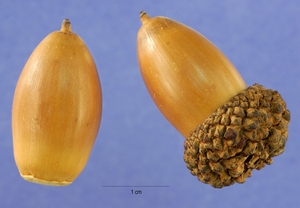 , 0.7–15 mm long, globoseglobose:
, 0.7–15 mm long, globoseglobose:
3D shape—more or less spherical
 to teardrop-shapedteardrop-shaped:
to teardrop-shapedteardrop-shaped:
2D shape—widest point is toward one end of the fruit, the other end tapers sharply to a pointed end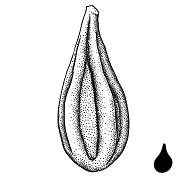 , angledangled:
, angledangled:
2D shape—having sides that meet at acute or obtuse angles
or tereteterete:
approximately circular in cross section; width and thickness approximately equal
 in transectiontransection:
in transectiontransection:
a cross section; representing a plane made by cutting across an organ at a right angle to its length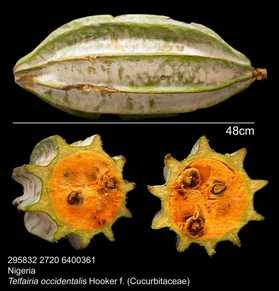 , persistent stylar beaks (Catacolea, Lepidobolus, and some species of Coleocarya and Harperia), one seeded (nut) or few seeded. NutsNuts:
, persistent stylar beaks (Catacolea, Lepidobolus, and some species of Coleocarya and Harperia), one seeded (nut) or few seeded. NutsNuts:
a fairly large, indehiscent, dry fruit with a thick and bony wall surrounding a single seed
 are often shed with persistent glumesglumes:
are often shed with persistent glumesglumes:
one of the (usually) two bracts at the base of a grass spikelet
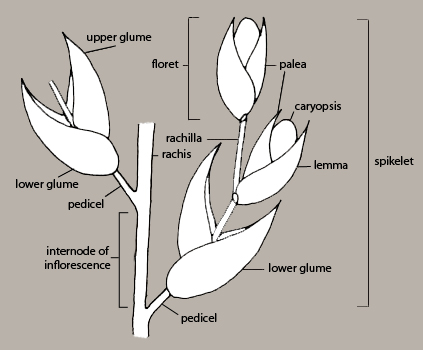 and/or a persistent perianthperianth:
and/or a persistent perianthperianth:
collective term for calyx and corolla of a flower
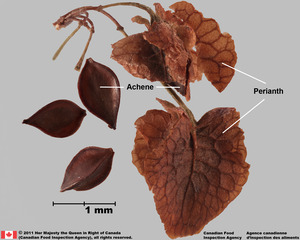 . Perianthperianth:
. Perianthperianth:
collective term for calyx and corolla of a flower
 is membranousmembranous:
is membranousmembranous:
texture—extremely thin, pliable, and fairly tough
or cartilaginouscartilaginous:
texture—firm, dense, tough, somewhat pliable, and resilient, like cartilage
and shorter (Willdenowia, Hypolaena) or longer than the nutnut:
a fairly large, indehiscent, dry fruit with a thick and bony wall surrounding a single seed
 . Hypodicus, Desmocladus, Catacolea, Kulinia, Lepidobolus, Willdenowia nutsnuts:
. Hypodicus, Desmocladus, Catacolea, Kulinia, Lepidobolus, Willdenowia nutsnuts:
a fairly large, indehiscent, dry fruit with a thick and bony wall surrounding a single seed
 are also shed with a fleshyfleshy:
are also shed with a fleshyfleshy:
texture—fairly firm and dense, juicy or at least moist, and easily cut
pedicel nearly elaiosomeelaiosome:
a lipid and protein-rich fleshy structure attached to some seeds and fruits, it attracts ants which then disperse the disseminule (e.g., caruncle in the Euphorbiaceae, the aril (outgrowth of the funiculus) in the Fabaceae)
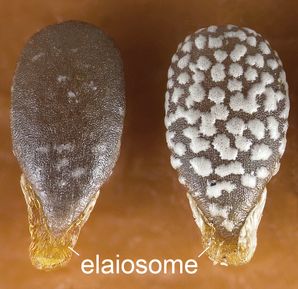 like in Wildenowia. In Hypolaena, nutsnuts:
like in Wildenowia. In Hypolaena, nutsnuts:
a fairly large, indehiscent, dry fruit with a thick and bony wall surrounding a single seed
 are shed with thickened pedicelpedicel:
are shed with thickened pedicelpedicel:
the stalk of a flower
, perianthperianth:
collective term for calyx and corolla of a flower
 , bracts, and glumeglume:
, bracts, and glumeglume:
one of the (usually) two bracts at the base of a grass spikelet
 or as a spikeletspikelet:
or as a spikeletspikelet:
basic unit of the grass inflorescence, commonly consisting of a pair of glumes and one to many florets
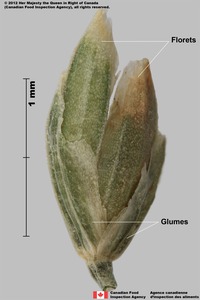 . In Meeboldina and Chaetanthus, the persistent perianthperianth:
. In Meeboldina and Chaetanthus, the persistent perianthperianth:
collective term for calyx and corolla of a flower
 bears or is modified to awnsawns:
bears or is modified to awnsawns:
a narrow, bristle-like organ, as on the glumes or lemmas of grasses
 , hairs or laterallateral:
, hairs or laterallateral:
(of embryo) embryo lies along the side of the seed, generally towards one end; of, at, or from the side; in grasses, can refer to the sides adjacent to the dorsal and ventral sides
wings. Pericarppericarp:
fruit wall or fruit coat
black, brown, gray, green, yellow, or brown, shinyshiny:
uniformly reflecting a high proportion of incident light at all angles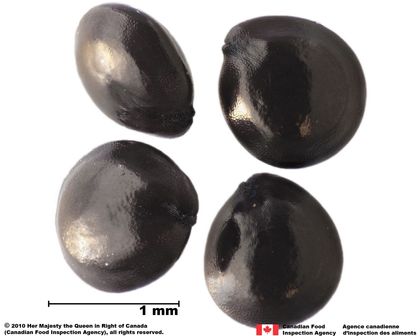 , membranousmembranous:
, membranousmembranous:
texture—extremely thin, pliable, and fairly tough
, woodywoody:
consisting mainly of indurate lignified tissues, characteristic of or resembling wood
, indurateindurate:
texture—hardened or stony; yielding under strong pressure; not deformable without internal structural disruption
, or leatheryleathery:
texture—moderately thick, tough, and very pliable
, smooth or variously ornamented.
Seed globoseglobose:
3D shape—more or less spherical
 to fusiformfusiform:
to fusiformfusiform:
spindle-shaped; broadest at the middle and tapering at both ends
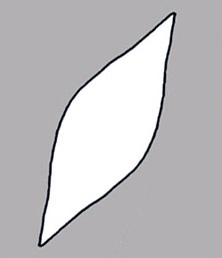 , 0.7–3 mm long [7–10 mm long, Alexgeorgea], rapheraphe:
, 0.7–3 mm long [7–10 mm long, Alexgeorgea], rapheraphe:
a ridge or seam on the seed coat, formed by the portion of the funiculus united to the ovule wall in longitudinally curved ovules
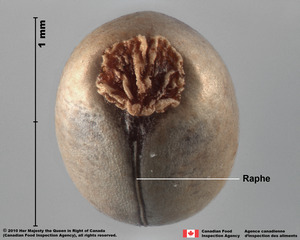 may be conspicuous. Seed coat brown, gray, or white, shinyshiny:
may be conspicuous. Seed coat brown, gray, or white, shinyshiny:
uniformly reflecting a high proportion of incident light at all angles , hard or membranousmembranous:
, hard or membranousmembranous:
texture—extremely thin, pliable, and fairly tough
, thinthin:
having or being of relatively little depth
, smooth or variously ornamented.
Embryo rudimentaryrudimentary:
(of embryo) embryo is small and fills less than a quarter of the seed and can be variable in shapes, such as linear, spatulate, or oval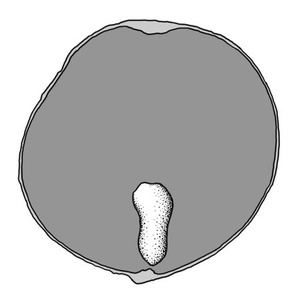 , angularangular:
, angularangular:
2D shape—having sides that meet at acute or obtuse angles
, spatulatespatulate:
2D shape—like a spatula; rounded at the apex, with base long and tapered; (of embryo) embryo is straight and axile and centric with the cotyledons expanded to form the shape of a spatula or spoon; (of cotyledons) cotyledons expanded and wider than the stalk but not invested into the stalk , or broad, straight, caping one end of endospermendosperm:
, or broad, straight, caping one end of endospermendosperm:
nutritive starch- and oil-containing tissue present in many seeds
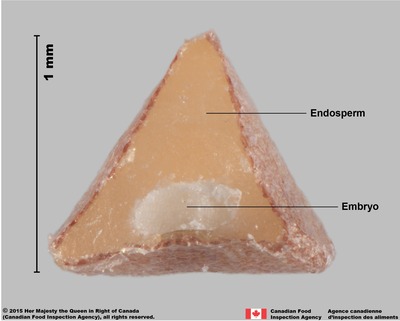 or lying along one side, partially filling seed coat. Endospermendosperm:
or lying along one side, partially filling seed coat. Endospermendosperm:
nutritive starch- and oil-containing tissue present in many seeds
 copious, mealymealy:
copious, mealymealy:
loose, dry, and disintegrating in finely granular
pieces like meal or flour
.
| Fruit | |
| Type | capsule, folliclefollicle: a dry to (rarely) fleshy fruit derived from a single carpel that opens along a single longitudinal suture; the seeds may be arillate or with a fleshy testa  , nut , nut |
| Size range | 0.7–15 mm |
| Shape(s) | globose, oblongoblong: 2D shape—much longer than broad with nearly parallel sides, corners are rounded  , ovoidovoid: , ovoidovoid:3D shape—ovate  , ellipsoidellipsoid: , ellipsoidellipsoid:3D shape—elliptic , trigonoustrigonous: 3D shape—having three faces that meet at distinct angles; triangular in outline , teardrop-shapedteardrop-shaped: 2D shape—widest point is toward one end of the fruit, the other end tapers sharply to a pointed end  , cuneiformcuneiform: , cuneiformcuneiform:=wedge-shaped , cylindrical |
| Texture | membranous, woodywoody: consisting mainly of indurate lignified tissues, characteristic of or resembling wood , indurateindurate: texture—hardened or stony; yielding under strong pressure; not deformable without internal structural disruption , leathery |
| Surface relief | smooth, ridgedridged: surface relief—raised, thick ridges, sharp edged or rounded, usually in a series that may cover the entire surface 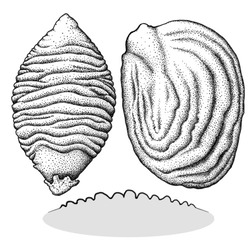 , striatestriate: , striatestriate:surface relief—having fine, parallel lines, grooves or ridges  , wrinkledwrinkled: , wrinkledwrinkled:surface relief—shallow, irregular folds and furrows covering the surface; appearing overall though crumpled and then spread out  , papillatepapillate: , papillatepapillate:surface relief—bearing minute, distinct, broad-based projections, tapering to a rounded apex  , colliculatecolliculate: , colliculatecolliculate:surface relief—covered with small, round projections, similar to blistered 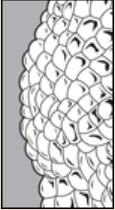 , punctate , punctate |
| Color(s) | black, brown, gray, green, purple, yellow |
| Unique features | Small capsulescapsules: a dry, dehiscent fruit formed by two or more carpels  , folliclesfollicles: , folliclesfollicles:a dry to (rarely) fleshy fruit derived from a single carpel that opens along a single longitudinal suture; the seeds may be arillate or with a fleshy testa  or nutsnuts: or nutsnuts:a fairly large, indehiscent, dry fruit with a thick and bony wall surrounding a single seed  often shed with persistent, membranousmembranous: often shed with persistent, membranousmembranous:texture—extremely thin, pliable, and fairly tough or cartilaginouscartilaginous: texture—firm, dense, tough, somewhat pliable, and resilient, like cartilage perianth, sometimes wing-like, and/or fleshyfleshy: texture—fairly firm and dense, juicy or at least moist, and easily cut pedicel and often ornamented, may appear like a grass spikeletspikelet: basic unit of the grass inflorescence, commonly consisting of a pair of glumes and one to many florets  . . |
| Seed | |
| Size range | 0.7–3 [7–10, Alexgeorgea] mm long |
| Shape(s) | fusiform, ovoidovoid: 3D shape—ovate  , oblongoblong: , oblongoblong:2D shape—much longer than broad with nearly parallel sides, corners are rounded  , ellipsoidellipsoid: , ellipsoidellipsoid:3D shape—elliptic , globoseglobose: 3D shape—more or less spherical  , cylindrical , cylindrical |
| Surface relief | striate, wartywarty: surface relief—distinct, rounded projections that are large relative to the fruit size; tuberculate, verrucose 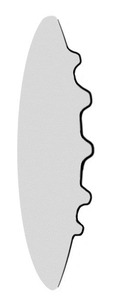 , spinyspiny: , spinyspiny:having slender, stiff, sharp projections oriented in the general plane of the structure 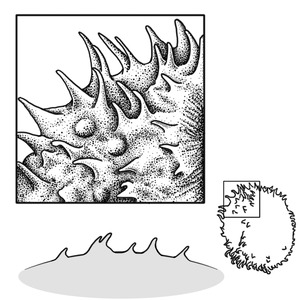 , with hookswith hooks: , with hookswith hooks:bristles or spines with curved or backwards pointing tips, or with secondary bristles along their length  , groovedgrooved: , groovedgrooved:surface relief—linear depressions that may be single or form a series of grooves over the surface  , ridgedridged: , ridgedridged:surface relief—raised, thick ridges, sharp edged or rounded, usually in a series that may cover the entire surface  , ribbedribbed: , ribbedribbed:surface relief—wide, prominent, linear ridges that are generally rounded and longitudinally situated on the surface 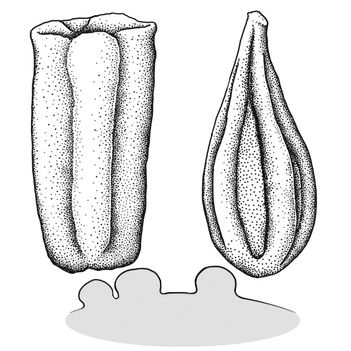 , colliculate , colliculate |
| Color(s) | brown, gray, white |
| Unique features | Seeds variously ornamented, sometimes translucenttranslucent: transmitting light uniformly and diffusely 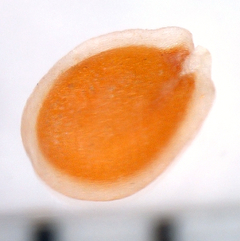 , often fusiformfusiform: , often fusiformfusiform:spindle-shaped; broadest at the middle and tapering at both ends  . . |
| Other | |
| Embryo | rudimentary, angularangular: 2D shape—having sides that meet at acute or obtuse angles , spatulatespatulate: 2D shape—like a spatula; rounded at the apex, with base long and tapered; (of embryo) embryo is straight and axile and centric with the cotyledons expanded to form the shape of a spatula or spoon; (of cotyledons) cotyledons expanded and wider than the stalk but not invested into the stalk  , or broad, straight, caping one end of endospermendosperm: , or broad, straight, caping one end of endospermendosperm:nutritive starch- and oil-containing tissue present in many seeds  or lying along one side, partially filling seed coat or lying along one side, partially filling seed coat |
| Nutritive tissuenutritive tissue: tissue within the seeds that nourishes the developing embryo; such as endosperm, perisperm, or chalazosperm in angiosperms; megagametophyte in gymnosperms |
endosperm endosperm: nutritive starch- and oil-containing tissue present in many seeds  copious, mealy copious, mealy |
Temperate Southern Hemisphere, especially Australia and southern Africa.
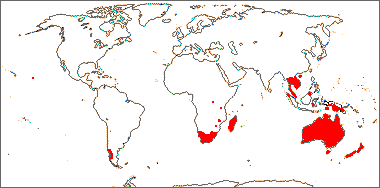
Distribution map courtesy of Angiosperm Phylogeny Website.
Baskin and Baskin 2021Baskin and Baskin 2021:
Baskin C and Baskin J. 2021. Relationship of the lateral embryo (in grasses) to other monocot embryos: A status up-grade. Seed Science Research 31 (3): 199-210. doi:10.1017/S0960258521000209; Dahlgren et al. 1985Dahlgren et al. 1985:
Dahlgren RMT, Clifford HT, and Yeo PF. 1985. The families of the monocotyledons: structure, evolution, and taxonomy. Springer-Verlag, Berlin. 520 pp.; Flora of Australia 2021+Flora of Australia 2021+:
Flora of Australia. Australian Biological Resources Study, Canberra. Accessed January-May 2021. URL: http://www.ausflora.org.au; Kirkbride et al. 2006Kirkbride et al. 2006:
Kirkbride JH, Jr, Gunn CR, and Dallwitz MJ. 2006. Family guide for fruits and seeds, vers. 1.0. Accessed September 2020ndash;January 2022. URL: https://nt.ars-grin.gov/seedsfruits/keys/frsdfam/index.cfm .; Kubitzki et al. 1990+Kubitzki et al. 1990+:
Kubitzki K et al., eds. 1990+. The families and genera of vascular plants. 7+ vols. Berlin etc.; Stevenson and Loconte 1995Stevenson and Loconte 1995:
Stevenson DW and Loconte H. 1995. A cladistic analysis of monocot families. In: Rudall PJ, Cribb PJ, Cutler DF, and Humphries CJ, eds. Monocotyledons: Systematics and Evolution. Royal Botanic Gardens, Kew.; Thiselton-Dyer 1897Thiselton-Dyer 1897:
Thiselton-Dyer WT. 1897. Flora capensis: being a systematic description of the plants of the Cape colony, Caffraria, amp; Port Natal (and neighbouring territories). Vol. 7. L. Reeve, Kent UK. 791 pp. https://doi.org/10.5962/bhl.title.821; Watson and Dallwitz 1992+Watson and Dallwitz 1992+:
Watson L and Dallwitz MJ. 1992+. The families of flowering plants: descriptions, illustrations, identification, and information retrieval. Version: 6th Accessed September 2020-September 2022. URL: delta-intkey.com
*The number of genera and species is based on Christenhusz and Byng 2016Christenhusz and Byng 2016:
Christenhusz MJM and Byng JW. 2016. The number of known plant species in the world and its annual increase. Phytotaxa 261 (3): 201ndash;217. https://doi.org/10.11646/phytotaxa.261.3.1, which may differ from the number of genera in GRIN-Global.